Warning: The following article on how Metal Gear Solid’s Codec calls peaked in the first games contains spoilers for the Master Collection.
The Metal Gear series tells a story that stretches across multiple timelines and perspectives, but its identity is rock solid. Things like cardboard boxes, cyborg ninjas, and blood-curdling “SNAAAAAAAKE” screams are cemented in pop culture to such a degree that references to the series have snuck their way into various media for decades. Whether you’re saying la li lu le lo in your sleep or if you think Solid Snake’s just that guy from Super Smash Bros., chances are, there’s only one thing on your mind when you see an exclamation mark in the wild. I would argue that the Codec calls and all that they encompass are equally as recognizable.
For the uninitiated, Codec calls are story-heavy breaks from battle that see your main character, usually some variation of Snake, communicating with friends, buddies, and pals. These have existed, in some form, in nearly every Metal Gear Solid outing since the beginning. Even PlatinumGames’ action-focused spinoff Metal Gear Rising: Revengeance occasionally takes a breather with its own spin on those iconic digital conversations. Unlike most of the stealth-action series’ other iconography, though, Codec calls have been through a litany of revisions to the point where they’re barely recognizable in later entries. They didn’t just get facelifts as time went on, though – they got worse.
Related: The Untold Origins of the Metal Gear Mythology – Metal Gear Legend

I’ve been playing Metal Gear Solid: Master Collection Vol 1 for around a week now, and being able to switch between each game on the fly has really highlighted the Codec’s steep decline in quality after Metal Gear Solid 1. In fact, having each game laid out like this proved to me that, not only did the frequency-dialing feature peak with the PlayStation 1 original, but each following game subjected players to a progressively worse version of Codec calls. Although I generally believe each overall Metal Gear experience is better than the last, Codec calls are a sore spot on the series’ otherwise unparalleled rise in quality.
To be fair, any game would have to fight an uphill battle when competing against visuals drawn by legendary artist Yoji Shinkawa. He has a jaw-dropping ability to leave the smallest details dripping with style, and in Metal Gear Solid 1‘s Codec calls, it feels like every character was given an immense amount of love and attention. Snake is violently cool but absolutely capable of sneaking in a killer smirk, but his fear comes through when it matters, too. This legendary soldier and the rest of his team are never more human than when we see their back-and-forth in these Codec communications. Its presentation is wrapped up with iconic sound effects and a beautiful anime art style that hasn’t lost a pixel of intent in 25 years.
At least a few years separate the release of each Metal Gear Solid, leaving mastermind Hideo Kojima and his team to capitalize on one key component: technology. As time thrusted the series into the future, each entry was able to take advantage of better tech, resulting in more realistic graphics, newfound gameplay opportunities, and far more room to tell epic spy-thriller stories. No one game looks or plays alike, but every moment makes the most of what the developers had at the time, unquestionably. So, when I flip to Metal Gear Solid 2: Sons of Liberty, I understand why Codec calls feature 3D models instead of Shinkawa’s hand-drawn faces.
I can’t blame the team for its desire to showcase the power of the PlayStation 2, but the results don’t hold up after 22 years. I’m sure it was cool to see Snake, Raiden, Otacon, and the rest of the crew animated in full form back in 2001. Today, though, the cast is…kind of stiff when they chime in for the occasional Codec call. It’s never bad – the intensity of those late-game reveals is still unmatched – but I can’t help but wonder if these scenes would be more impactful if Kojima had opted to stick with the hand-drawn character portraits. I mean, can you imagine what it would be like to see Colonel Campbell’s face morph into a skull with Shinkawa’s art? Chills.
I’m nitpicking, obviously. Metal Gear Solid 2 is as much a masterpiece today as it was in 2001. One game that I think deserves to be criticized for its take on Codec calls, however, is Kojima’s Cold War prequel, Metal Gear Solid 3: Snake Eater. If you ask me on the right day, Big Boss’ origin story might be my favorite Metal Gear title, period, but that doesn’t stop it from staining the franchise’s com systems.
Snake’s portrait was completely severed from the third installment’s Codec segments and was replaced, instead, by a larger, more stylized model that floats ethereally in the background of calls. You’ll, more often than not, forget he’s back there, though, leaving David Hayter to do the heavy lifting with voice work. To make matters worse, the other side of the Codec is usually populated by static images of 3D renders of whomever you’re communicating with, with every conversation painted in drab sepia tones. It fits the setting but is an engaging, far cry from the lively Codec calls we got in Metal Gear Solid 1.

Metal Gear Solid 4: Guns of the Patriots, a game that I and thousands of other fans are praying makes it onto the inevitable Metal Gear Solid: Master Collection Vol 2, does have Codec calls…sort of. This divisive finale for Solid Snake essentially plays fully animated 3D cutscenes in front of players while our hero’s disembodied, elderly head talks back to whoever is on the other side. While better than what we saw in Metal Gear Solid 3, these videos also feel so far removed from the classic Codec calls that many often forget Metal Gear Solid 4 even has a Codec feature. Then, there’s Metal Gear Solid 5: The Phantom Pain, an equally divisive entry that did away with Codec calls completely, bringing a sad end to what was once an iconic, stylish series staple.
The Metal Gear Solid: Master Collection Vol 1 puts many of these Codec calls side by side, but the comparisons leave a clear victor. I’m not the only one who feels this way, either, as time hasn’t been kind to Codec iterations after Metal Gear Solid 1. Super Smash Bros. Brawl released in 2008 and features an Easter Egg that lets players access the Codec for intel on other fighters in the roster. The Nintendo fighting game favored that classic Codec style over either of the two other “updated” iterations. This same Easter Egg returned for 2018’s Super Smash Bros. Ultimate, so if Shinkawa’s Metal Gear Solid 1 Codec art hadn’t already been burned into players’ memories, then it might be now.
If you thought that video games were the only kind of media to channel the classic Codec’s sound, look, and feel, then think again. The feature’s most prominent (and strange) appearance might actually be tied to a vehicle to surpass Metal Gear: the Ford Focus SE. Yes, Hayter reprised his role to appear in a Codec call to advertise for Ford in 2016. It’s hilarious but also a painful reminder of what we lost after 1998.
I’m excited to see how the upcoming Metal Gear Solid 3 remake, Metal Gear Solid Delta: Snake Eater, revisits Codec calls. Maybe they will be the exact same as the original game’s, or maybe Shinkawa’s art style will return? Maybe it won’t have Codec calls at all? With no release date in sight, it’s hard to say, but I still have hope. Regardless, Metal Gear Solid 1 is a timeless classic with Codec calls that I know will hold up for decades to come.






Published: Oct 24, 2023 05:00 pm